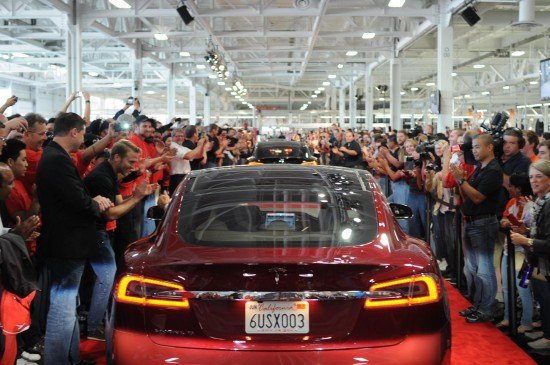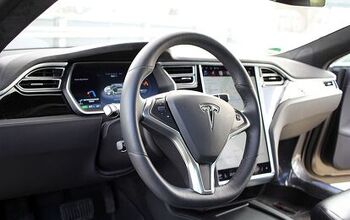Never Mind The Bollocks, Here's The Tesla Model S
If Elon Musk is still smarting about how much damage the New York Times has done to Tesla, the fledgling automaker can take comfort in the fact that the positive reviews are still pouring in.
For example, take a look at this glowing write-up on the Model S from Road & Track’s Jason Cammisa. Although the Tesla’s door handles receive a vigorous and thorough critical assessment, its other flaws are glossed over or simply omitted from consideration. After praising the Model S for its remarkable driving dynamics, amazing powertrain and homegrown pedigree, Cammisa gets to the real meat of the EV issue – and promptly sidesteps it all.
Set aside the discussion as to whether EVs are actually feasible given our overtaxed power grid, and whether our electricity-generating power plants are any more environmentally friendly than a really efficient gasoline engine. Ignore, for a moment, that we don’t know how the Model S will age or how reliable it will be a decade on. Time will answer all of these, as well as the question of whether Tesla itself can stay solvent long enough to survive into maturity. We set them aside with the knowledge that the Tesla S means these discussions will finally be worth having. The Model S is the car that proves that the EV isn’t just viable, but truly desirable.
In my opinion, the above paragraph represents a pulled punch with respect to the real issues surrounding Tesla and EVs. It’s fine to evaluate the performance, aesthetics and build quality of the Model S as one would with any other car, especially in a road test. But 0-60 times and lateral g’s are a small part of the picture here. If EVs do not contribute to a net reduction in carbon emissions, why bother with a powertrain that offers significant compromises over an ICE equivalent? If Tesla cannot keep itself afloat, or if the car will turn into a 4000-lb paperweight in a decade, is buying a Model S a prudent decision? Despite leaving these critical questions unanswered, Cammisa somehow asserts that EVs are in fact “viable” and that these discussions are “…will finally be worth having”.
My question is, why aren’t we having them already, in influential publications like Road & Track? Despite what Cammisa says, we don’t have to wait for time to pass before we know the answers. A bit of intellectual labor can give us a picture of how things will play out. Furthermore a publication like R&T has both the budget and freedom from the daily grind of the blogosphere news cycle to delve into these matters.
Sure, there are a number of agenda-driven entities that propagate bad information and do little to enhance the discourse, but isn’t journalism all about sifting through bad information to find the truth? I’ve been down this road before; when the “scandal” regarding the Tesla Roadster and “bricked” batteries came out early in 2012, TTAC was among the first to call bullshit on the claims of the plaintiffs. The exercise illuminated why doing the “hard work” was so important. This is an era where hearsay can quickly become fact – a dangerous prospect given how much bad information is already floating around out there. The onus is on us as journalists to, well, do our jobs and find out the truth – whether it’s getting to the bottom of a malicious smear campaign against a fledgling startup, or determining the viability of pure EVs outside of the normal “car guy” parameters of going fast and looking cool.
More by Derek Kreindler
Latest Car Reviews
Read moreLatest Product Reviews
Read moreRecent Comments
- SCE to AUX Over the last 15 years and half a dozen vehicles, my Hyundais and Kias have been pretty cheap to maintain and insure - gas, hybrid, and electric.I hate buying tires - whose cost goes by diameter - and I'm dreading the purchase of new 19s for the Santa Fe.I also have an 08 Rabbit in my fleet, which is not cheap to fix.But I do my own wrenching, so that's the biggest factor.
- MaintenanceCosts '19 Chevy Bolt: Next to nothing. A 12v battery and a couple cabin air filters. $400 over five years.'16 Highlander Hybrid, bought in 2019: A new set of brakes at all four corners, a new PCV valve, several oil changes, and two new 12v batteries (to be fair, the second one wasn't the car's fault - I had the misfortune of leaving it for a month with both third-row interior lights stealthily turned on by my kid). Total costs around $2500 over five years. Coming due: tires.'11 BMW 335i, bought in late 2022: A new HID low beam bulb (requiring removal of the front fascia, which I paid to have done), a new set of spark plugs, replacements for several flaking soft-touch parts, and two oil changes. Total costs around $1600 over a year and a half. Coming due: front main seal (slow leak).'95 Acura Legend, bought in 2015: Almost complete steering and suspension overhauls, timing belt and water pump, new rear brakes, new wheels and tires, new radiator, new coolant hoses throughout, new valve cover gaskets, new PS hoses, new EGR valve assembly, new power antenna, professional paint correction, and quite a few oil changes. Total costs around $12k over nine years. Coming due: timing belt (again), front diff seal.
- SCE to AUX Given this choice - I'd take the Honda Civic Sport Hatchback (CVT). I 'built' mine for $28777.To my eye, the Civic beats the Corolla on looks these days.But for the same money, I can get an Elantra N-Line with 7-speed DCT, 201 HP, and good fuel economy, so I'd rather go for that.
- Kwik_Shift_Pro4X '19 Frontier Pro 4X. Next to nothing. All oil changes are on schedule. Got new tires at 60000 miles. Still on original brakes at 79000 miles. Those are due soon. Brakes complete estimate $1000 all in.
- Dr.Nick The cars seem really expensive with tight back seats and Cadillac was on the list of the highest price gouging dealers coming out of COVID. I don’t understand the combination, shouldn’t they be offering deals if they are not selling?































Comments
Join the conversation
“If EVs do not contribute to a net reduction in carbon emissions, why bother with a powertrain that offers significant compromises over an ICE equivalent?” Maybe for the significant advantages it offers over an ICE equivalent? Reviews always mention the abundant torque of the Model S. How about a motor’s reliability & cost of maintenance compared to an ICE? What about the advantages of packaging of the Model S? (While there is the “frunk,” I was actually thinking of a complete lack of hump.)
There is a philosophical divide concerning whether you should choose your car because it can accomplish your most demanding driving situation, or if you should drive something else (probably smaller and less powerful) which handles the vast majority of your needs and rent/borrow for the remaining bit. I think the average pick-up truck owner would save money over all if he drove a sedan and hired a delivery truck whenever he needed something big moved. (I say HE because the owners are usually male.) Of course, it's not just about money, it's about something more personal. In the United States, our relatively cheap gasoline lets us indulge and drive big vehicles with relatively little penalty. If all of the external costs of burning the fuel were factored into the price of the fuel, we might make different decisions.